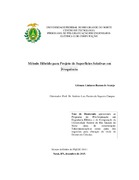Please use this identifier to cite or link to this item:
https://repositorio.ufrn.br/handle/123456789/21140| Title: | Método híbrido para projeto de superfícies seletivas em frequência |
| Authors: | Araújo, Gilmara Linhares de |
| Advisor: | Campos, Antonio Luiz Pereira de Siqueira |
| Keywords: | Superfícies seletivas em frequências;Método do circuito equivalente;Algoritmo genético;Síntese de FSS;Função fitness;Optimtool |
| Issue Date: | 10-Dec-2015 |
| Publisher: | Universidade Federal do Rio Grande do Norte |
| Citation: | ARAÚJO, Gilmara Linhares de. Método híbrido para projeto de superfícies seletivas em frequência. 2015. 140f. Tese (Doutorado em Engenharia Elétrica e de Computação) - Centro de Tecnologia, Universidade Federal do Rio Grande do Norte, Natal, 2015. |
| Portuguese Abstract: | Esse trabalho apresenta uma técnica híbrida de projeto de superfícies seletivas em frequência, sobre uma camada dielétrica isotrópica, considerando diversas geometrias para os elementos das células unitárias. Especificamente, a técnica híbrida usa o método do circuito equivalente em conjunto com algoritmos genéticos, visando a síntese de estruturas com resposta singleband e dual-band. O método do circuito equivalente permite modelar a estrutura por meio de um circuito equivalente e também a obtenção de circuitos para diferentes geometrias. A partir da obtenção dos parâmetros desses circuitos, podem-se obter as características de transmissão e de reflexão das estruturas modeladas. Para obter a otimização das estruturas modeladas, de acordo com a resposta em frequência desejada, a ferramenta de otimização do Matlab optimtool mostrou-se de fácil utilização, permitindo explorar resultados importantes na análise de otimização. No trabalho, são apresentados resultados numéricos e experimentais para as características de transmissão de diferentes geometrias analisadas. Foram efetuadas comparações com resultados apresentados na literatura, tendo-se observado uma boaconcordância nos casos analisados para estruturas com substratos isotrópicos. |
| Abstract: | This thesis presents a hybrid technique of frequency selective surfaces project (FSS) on a isotropic dielectric layer, considering various geometries for the elements of the unit cell. Specifically, the hybrid technique uses the equivalent circuit method in conjunction with genetic algorithm, aiming at the synthesis of structures with response single-band and dual-band. The equivalent circuit method allows you to model the structure by using an equivalent circuit and also obtaining circuits for different geometries. From the obtaining of the parameters of these circuits, you can get the transmission and reflection characteristics of patterned structures. For the optimization of patterned structures, according to the desired frequency response, Matlab™ optimization tool named optimtool proved to be easy to use, allowing you to explore important results on the optimization analysis. In this thesis, numeric and experimental results are presented for the different characteristics of the analyzed geometries. For this, it was determined a technique to obtain the parameter N, which is based on genetic algorithms and differential geometry, to obtain the algebraic rational models that determine values of N more accurate, facilitating new projects of FSS with these geometries. The optimal results of N are grouped according to the occupancy factor of the cell and the thickness of the dielectric, for modeling of the structures by means of rational algebraic equations. Furthermore, for the proposed hybrid model was developed a fitness function for the purpose of calculating the error occurred in the definitions of FSS bandwidths with transmission features single band and dual band. This thesis deals with the construction of prototypes of FSS with frequency settings and band widths obtained with the use of this function. The FSS were initially reviewed through simulations performed with the commercial software Ansoft Designer ™, followed by simulation with the equivalent circuit method for obtaining a value of N in order to converge the resonance frequency and the bandwidth of the FSS analyzed, then the results obtained were compared. The methodology applied is validated with the construction and measurement of prototypes with different geometries of the cells of the arrays of FSS. |
| URI: | https://repositorio.ufrn.br/jspui/handle/123456789/21140 |
| Appears in Collections: | PPGEE - Doutorado em Engenharia Elétrica e de Computação |
Files in This Item:
| File | Description | Size | Format | |
|---|---|---|---|---|
| GilmaraLinharesDeAraujo_TESE.pdf | 11,11 MB | Adobe PDF |  View/Open |
Items in DSpace are protected by copyright, with all rights reserved, unless otherwise indicated.

